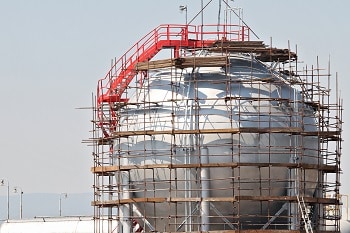The Value of Professional Tank Welding Inspection Solutions
The Value of Professional Tank Welding Inspection Solutions
Blog Article

Understanding the Relevance of Rigorous Container Welding Assessment Processes in Averting Failures and Enhancing Life Expectancy
In the world of commercial procedures, the value of strenuous storage tank welding assessment procedures can not be overstated. By implementing various examination methodologies, companies can discover problems early, therefore staying clear of costly consequences and extending the life of their storage space containers.
Significance of Welding Inspections
Recognizing the important function of welding evaluations in keeping structural integrity, these procedures ensure that welds meet established criteria and requirements - Tank Welding Inspection. Efficient welding examinations are vital in the construction and upkeep of tanks, as they straight affect the sturdiness and safety of the structures. By recognizing prospective deficiencies, such as inappropriate strategies or material problems, assessments alleviate the risk of tragic failures
Welding assessments encompass various techniques, including aesthetic examinations, non-destructive testing (NDT), and evaluations of welding treatments. Each method offers to confirm the high quality and compliance of welds with industry regulations, therefore safeguarding both employees and environmental interests. Normal evaluations cultivate a culture of accountability and excellence within the labor force, ensuring that all team participants stick to best methods.
Moreover, these evaluations add to the overall lifecycle management of containers by recognizing wear or degradation early while doing so. By dealing with these concerns proactively, organizations can prolong the operational lifespan of their possessions, inevitably resulting in set you back financial savings and improved dependability. In recap, the value of welding inspections can not be overemphasized; they are necessary for making sure safety, long life, and compliance in tank construction and maintenance.
Common Root Causes Of Tank Failures
Comprehending the typical root causes of container failings is important for stopping tragic incidents and guaranteeing the longevity of storage space systems. One prevalent reason for tank failure is rust, which can considerably damage the structural integrity of containers over time. Ecological aspects, such as direct exposure to wetness, chemicals, and temperature level fluctuations, can increase this process.
Another vital aspect is improper welding techniques, which might bring about problems like fractures or incomplete joints. These concerns can compromise the tank's strength and bring about leakages or tears. Furthermore, poor upkeep techniques can lead to undetected damage, eventually boosting the threat of failure.
Design flaws, consisting of inadequate thickness or poor material option, can also add to container vulnerabilities. Furthermore, operational variables, such as overfilling or exposure to severe pressures, can stress the storage tank beyond its desired limits.
Key Assessment Strategies
Reliable examination methods play an essential role in alleviating the risks related to tank failings. An extensive strategy to tank welding assessment involves a number of key strategies, each made to identify great site possible flaws and make sure architectural stability.
Visual evaluation remains the very first line of defense, permitting assessors to recognize surface area abnormalities such as splits, deterioration, or imbalance. This method is typically supplemented by non-destructive screening (NDT) methods, which are crucial for evaluating weld top quality without endangering the tank's stability.

Furthermore, magnetic particle screening (MPT) and dye penetrant testing (DPT) work for finding surface area issues in ferromagnetic Check Out Your URL products and non-porous surface areas, respectively. Each technique has its toughness and limitations; consequently, a combination of approaches is usually utilized to accomplish extensive evaluation outcomes.
Benefits of Rigorous Evaluations
While the immediate costs of strenuous evaluations may seem challenging, the lasting benefits dramatically surpass these initial investments. Implementing comprehensive assessment processes not just enhances the stability and security of storage tank structures however additionally reduces the threat of disastrous failures that can result in significant financial losses and ecological damage.
Strenuous evaluations assist determine potential issues early in the welding procedure, enabling prompt corrective actions that prevent expensive repair services or substitutes down the line. This aggressive approach fosters a additional info society of quality control, where adherence to finest practices ends up being ingrained in functional treatments. Furthermore, normal assessments add to increased asset longevity, as they ensure that storage tanks stay in optimal problem throughout their lifespan.
Furthermore, the documents produced from these evaluations works as a beneficial resource for maintenance planning and performance evaluations. This data-driven strategy can additionally enhance operational efficiency, causing reduced downtime and boosted productivity. Ultimately, strenuous assessments not only safeguard the architectural integrity of tanks but additionally give substantial economic advantages, strengthening the concept that purchasing top quality guarantee is a wise choice for any type of company entailed in storage tank operations.
Regulative Standards and Conformity
Governing standards and compliance are essential components of container welding inspection processes, as they develop the structure for ensuring security and high quality in operations. Conformity with these requirements not just reduces threats however likewise boosts the total honesty of bonded structures. Numerous companies, consisting of the American Culture of Mechanical Engineers (ASME) and the American Petroleum Institute (API), offer guidelines that dictate appropriate practices for welding, assessment, and screening.
These requirements mandate using certified personnel, the application of extensive evaluation methods, and adherence to certain welding procedures. By lining up with regulatory demands, companies can make sure that their tanks satisfy the essential safety and performance criteria, thereby decreasing the possibility of tragic failings that can lead to substantial economic losses and environmental damage.

Additionally, regulative conformity promotes a culture of responsibility and constant renovation within the welding and manufacture sectors (Tank Welding Inspection). Normal audits and evaluations guarantee that practices remain straightened with developing standards, therefore promoting lasting dependability and operational performance. Eventually, adherence to governing standards not only protects possessions yet additionally enhances the life-span of welded tanks, guaranteeing they offer their designated objective successfully with time
Conclusion
In final thought, extensive storage tank welding evaluation procedures play an important duty in stopping failings and expanding the life expectancy of storage structures. By recognizing potential deficiencies through various examination methods, organizations can mitigate threats associated with container honesty.
Report this page